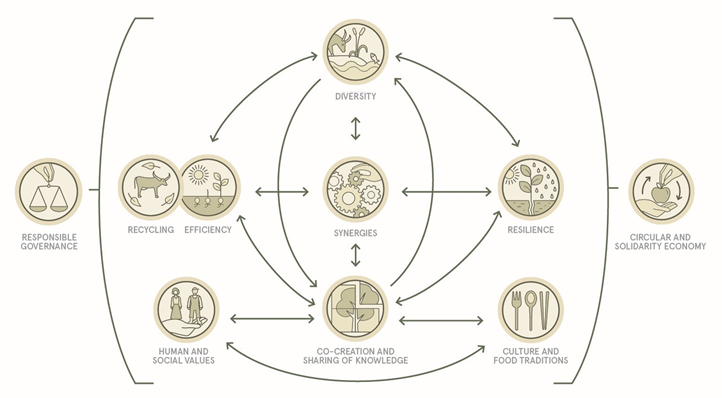July 2025, spin
How Regenerative Agriculture Can Reshape the Textile Industry
Regenerative agriculture is gaining global attention as a transformative approach to land management, offering solutions to soil degradation, biodiversity loss, and climate instability. But its relevance does not stop at food production. The textile industry—deeply rooted in agriculture through the cultivation of fiber crops and the raising of animals—can play a vital role in this regenerative shift.
By aligning textile sourcing with the principles of regenerative agriculture, the sector can become a driver of ecological restoration rather than environmental degradation.
Why Regenerative Agriculture Matters
Regenerative agriculture is defined not only by its aim to sustain existing ecosystems but by its commitment to actively restore and improve them. It is guided by five core principles:
1. Keep the Soil Covered Maintaining continuous soil cover—through cover crops, mulching, or plant residues—protects against erosion, enhances fertility, boosts biodiversity, and promotes carbon sequestration. (FAO, 2021)
2. Minimize Soil Disturbance Reduced tillage and limited use of chemical inputs protect soil structure and microbial communities, essential for long-term productivity and ecosystem resilience. (Rodale Institute, 2020)
3. Preserve Living Roots Year-Round Living roots feed soil biology and improve nutrient cycling, contributing to greater carbon retention in the soil. This is particularly relevant for perennial fiber crops and rotational systems. (NRCS, USDA)
4. Increase Species Diversity Biodiverse systems are more resilient to climate shocks and pests. Incorporating crop rotation and polycultures reduces dependence on chemical interventions and supports soil health. (IPBES, 2019)
5. Integrate Livestock
When managed holistically, livestock contribute to nutrient cycling, enhance soil organic matter, and improve land productivity without the environmental cost of intensive systems. (Savory Institute, 2018)
The Link: From Soil to Fiber
Fiber crops such as cotton, hemp, flax, and animal-based fibers like wool and alpaca are deeply tied to land use. Yet the conventional agricultural methods used in their production often rely on monocultures, synthetic inputs, and intensive irrigation—practices that deplete rather than replenish.
Regenerative agriculture offers a viable alternative by:
• Restoring degraded soils, enhancing long-term fiber yield and quality;
• Reducing greenhouse gas emissions, and in some cases, sequestering carbon;
• Protecting water sources by reducing chemical runoff and improving soil water retention;
• Improving livelihoods through more resilient and diversified farm systems. (Textile Exchange, 2022)
As fiber-producing regions face increasing pressures from climate change and market volatility, regenerative systems offer greater ecological stability and economic predictability.
Agroecology: A Broader Framework for Regeneration
In supporting countries to transition toward sustainable agriculture at scale, achieve food security, and meet the Sustainable Development Goals (SDGs), the FAO’s regional seminars on agroecology (2018) identified 10 key elements for systemic change (Figure 1).
These apply not only to food systems but also to natural fiber production and regenerative textile sourcing:
1. Diversity – Ensures food and fiber security while preserving natural resources.
2. Co-creation and Sharing of Knowledge – Solutions are most effective when locally rooted and developed collaboratively.
3. Synergies – Interconnected systems improve ecosystem services and productivity.
4. Efficiency – Regenerative and agroecological practices do more with fewer external inputs.
5. Recycling – Closing nutrient loops reduces costs and environmental impacts.
6. Resilience – Enhances the capacity of communities and ecosystems to adapt to change.
7. Human and Social Values – Supports equity, rural livelihoods, and social well-being.
8. Culture and Food Traditions – Preserves dietary diversity and cultural identity.
9. Responsible Governance – Encourages participatory decision-making and fair access to resources.
10. Circular and Solidarity Economy – Reconnects producers and consumers, fostering innovation and sustainable development.
(FAO, 2018)
Together with the core regenerative principles, these elements frame an inclusive and holistic vision for how land-based industries—including textiles—can align with planetary boundaries while promoting human well-being.
 Figure 1: The 10 elements of agro-ecology (FAO, 2018)
Figure 1: The 10 elements of agro-ecology (FAO, 2018)
Building Regenerative Supply Systems
For the textile industry to fully realize the potential of regenerative agriculture, it must invest in transparent, localized, and biologically sound supply chains. This includes:
• Collaborating with agricultural researchers and land stewards;
• Developing traceability tools to verify regenerative practices;
• Supporting certification systems rooted in ecological outcomes (not just input substitution);
• Fostering long-term relationships with producers committed to regeneration.
Conclusion: A Regenerative Opportunity
Bridging regenerative agriculture and the textile industry is not a technical challenge—it is a strategic opportunity. As the world faces intersecting crises of climate change, soil loss, and unsustainable consumption, the integration of regenerative practices into textile supply chains represents a crucial pathway forward. From the ground we farm to the garments we wear, regeneration is both a necessity and a possibility.
Publication date: 2025-07-07